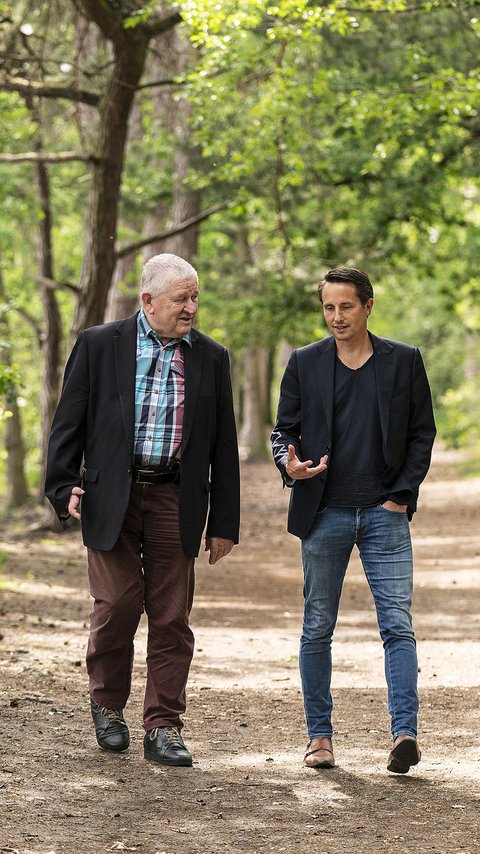
Timber is both one of the oldest and most future-proof building materials on Earth. Thanks to its large-scale timber-frame construction, Heijmans is well on the way to achieving circular building practices. But how do we get the whole chain on board in this material transition? Thijs Huijsmans, Circular Building Advisor at Heijmans, talks about this with Jos Lichtenberg, a Professor Emeritus at Technical University (TU) Eindhoven.
Some people think of a timber house as a chalet or log cabin. But timber houses come in all shapes and sizes, says Jos Lichtenberg, Professor Emeritus of product development at TU Eindhoven. He knows, because he lives in one of these houses. "Mine has a wooden finish, but some timber-frame houses have a stucco finish on the inside and brickwork on the outside. Just like a traditionally built house. You can only hear the difference when you knock on the walls.”
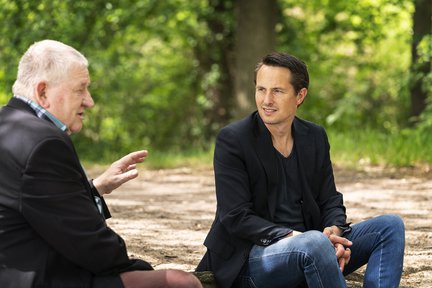
A timber-frame house has a shell of wooden frames and is just as sturdy as a brick house, explains Thijs Huijsmans, Circular Building Advisor at Heijmans. Heijmans started making these homes on a large scale this year, in the IIBO production facility in Heerenveen. "This is where we produce timber elements, which we then use to build a house both smartly and quickly on the building site
Driver
Rapid production is far from being a luxury, given the current housing shortage in the Netherlands. In addition, timber is strong, light and renewable, says Thijs. "It's bio-based: this material simply grows in nature. The production of steel and concrete releases a lot of CO2, the biggest culprit in climate change. Timber absorbs CO2."
Jos is just as enthusiastic about the use of timber in construction. "It's an age old material, which is highly sought after and loved, and is close to people." This is not just an aesthetic or practical choice, he believes: you can also use it to reduce your carbon footprint. "Concrete production is responsible for about five to nine percent of global greenhouse gas emissions," says Jos "That's a huge amount."
Imbalance
What's more, concrete that is released from construction projects cannot simply be broken down and reused in its entirety. And aluminium is frequently even exported after use, says Jos. "It disappears from the Netherlands, while we continue to buy primary raw materials. This is a shame, Thijs agrees: "Environmental calculations are often based on ecological depreciation of one hundred years, but in practice concrete is often downcycled or thrown away much sooner. It is possible to reuse these materials by reducing them to raw materials, but it takes a lot of energy."
There is an imbalance between the use of primary raw materials and their reuse, the two men conclude. And this is while the Netherlands is supposed to be a circular economy by 2050, an economy in which we make full use of recycled or renewable raw materials.
Material transition
It’s time for a change, says Thijs. "We need a material transition in the construction sector. The failure to make that transition will be harmful to both the environment and to the construction sector, he argues. "If European legislation sets a CO2 limit, because the maximum environmental impact has been reached, the brakes will go on. Then we'll have to cut back on construction."
Reducing CO2 emissions is something the construction sector is working hard on. Jos: "We are increasingly looking at ways of using and reusing materials as efficiently as possible. A timber-frame house is a good example of this, he says. Individual elements of such a house, such as wooden internal walls, can be detached at the end of their life and reused - in their entirety, as a component or as a raw material, says Jos.
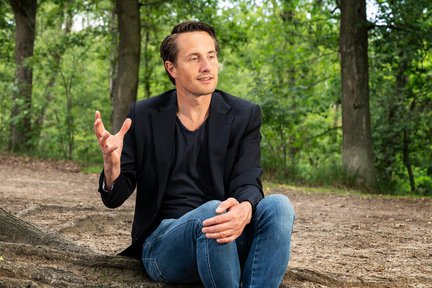
He believes that this is not just sustainable, as it also responds to housing demand. "The days of a model family consisting of father, mother and two children are over. We now have many more different types of family and living requirements are constantly changing. The demand for smaller, affordable and flexible homes is increasing.
Adaptive buildings
Rapidly changing housing requirements call for quick adjustments, agrees Thijs. "Ultimately, I want to work towards a system in which residents of Heijmans’ timber-frame houses can choose new elements from a catalogue. If you need more space, then we take the old material back. That way, we ensure that it stays in the cycle."
This will require a plug-and-play type of construction. Right from the design phase, we have to consider the question: how can this building be dismantled in the future? "The adaptive potential of buildings is important on this front," says Thijs. "Which elements are 'short cycle' and which are supposed to last longer? An inner wall, for example, may not be load-bearing. You have to be able to remove it when you want to rearrange rooms, without causing any damage. Circular construction requires a new way of thinking."
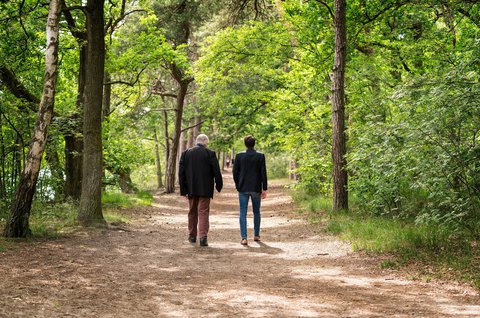
A lot of work to be done
If we're to move to one hundred percent circular building by 2023, as Heijmans aims to do, everyone in the chain has to be fully committed: home buyers, the construction industry and our collaboration partners. There's a lot work to be done, says Jos. "Some buyers are already making a conscious choice for a timber-frame house, but the general public is not yet used to the idea of a house with wooden walls, floors and ceilings. Yet timber frame homes meet many of the requirements of today's buyers: they are well insulated, dampen vibration and noise, and can be heated and cooled quickly."
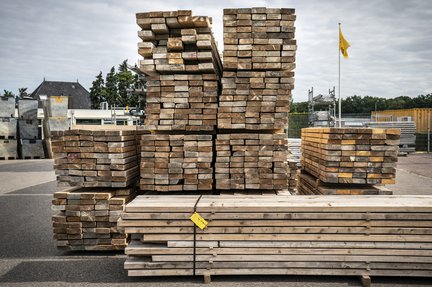
These qualities cannot be stressed enough, says Thijs. "It is simply extremely comfortable and pleasant to live in a timber-frame house. On top of this, we do need to keep explaining why we must stop using such heavy materials. Homes are being consumed at an ever-increasing rate; we are heading towards ten billion people. When you consider how many kilograms of materials there are in homes and where they come from, it's clear that something has to change."
And the time is ripe for this change, Jos and Thijs think: one mortgage lender recently offered an extra-low interest rate for buyers of a bio-based home. "We also need that financial incentive for the material transition."
Changing
Although the construction industry is changing, building ever more lightly and more flexibly, it is generally slow to change, Jos believes. "No matter how much you want something to change today, you can't get all the construction companies, designers, advisors and collaborating parties on board right away. Some people are afraid of change or think that timber construction is more expensive. But ultimately, we have to do it together. If we explain the long-term benefits of timber and we can show good examples, we will see an increase in the willingness to change. Each time, you gain a little ground, until an irreversible process is underway. We are now approaching that point."
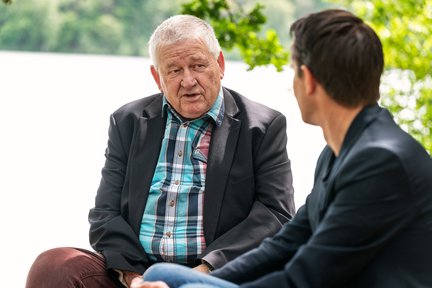
We will continue to need steel and concrete for certain purposes, says Thijs. But as construction companies, we can think more in terms of material flows. "When we buy materials, we need to know precisely: where does it come from, has it been extracted in a healthy way and how are we going to use it in our buildings? We really can reduce the share of primary raw materials. There are three strategies for this, and we need to consider all of them: fewer materials, more secondary materials and more renewable materials."
The construction industry has already gone through an energy transition and this will now be followed by a material transition
Thijs is confident that this will happen. "The construction industry has already gone through an energy transition and this will now be followed by a material transition." What the future holds? Thijs is currently researching which bio-based materials can replace rock wool and glass wool as insulation materials. Wood fibre, perhaps? Jos: "If you can recycle building materials at a high level, you create a lot of value for the future. In twenty years' time, for example, when materials are even more scarce, we will find it quite normal to use used building parts or components as full products. So now is the time to think about future reuse.
Contact us

